Vermeer Audio Model TWO Universal Control Center

 It is a rare occasion when the unveiling of a piece of audio gear causes me to respond with a breathless… “damn.” The first thought that I had was to make sure that my security system was working because I knew that I was looking at a very expensive piece of equipment. Don’t get me wrong, I’ve had expensive gear in my house for review before but not everything that has been sent to me looked like what it cost. That was not the case with the Vermeer Audio Model TWO Universal Control Center. It has the look and feel of a component that declares, “You’re playing with the big boys now!” This is how my time with the Model TWO began.
It is a rare occasion when the unveiling of a piece of audio gear causes me to respond with a breathless… “damn.” The first thought that I had was to make sure that my security system was working because I knew that I was looking at a very expensive piece of equipment. Don’t get me wrong, I’ve had expensive gear in my house for review before but not everything that has been sent to me looked like what it cost. That was not the case with the Vermeer Audio Model TWO Universal Control Center. It has the look and feel of a component that declares, “You’re playing with the big boys now!” This is how my time with the Model TWO began.
And actually, my impressions of this company started before I even got to the point of unveiling this gorgeous unit. It is fairly normal for a high-end component to come shipped in a sturdy cardboard box packed inside another sturdy cardboard box. But the Model TWO came shipped in a sturdy cardboard box packed inside an ingenious and fairly attractive heavy-duty cardboard box/wooden crate hybrid. That’s right. They took a heavy-duty cardboard box and added solid wood side panels. They also added metal latches to the box that you can put locks on for added security. This immediately had me thinking, “An awful lot of thought went into the design of their packaging. I can’t wait to see (and hear) what they did with the unit.” So let’s get into it.
About Vermeer
The name Vermeer Audio may be a relatively new one but make no mistake, this is not a new company. That’s because the folks at Vermeer Audio acquired the venerable audio company, Audio Aero, lock stock and barrel in late 2014. Audio Aero was a Toulouse, France-based company made famous by their gorgeous CD players, the Prestige and the Capitole. They later made the LaSource and LaFontaine CD players which were the foundation of the Vermeer line. In fact, Vermeer still handles the service and updating of the LaSource and LaFontaine and even lets you upgrade these existing Audio Aero models to Vermeer products.
Vermeer Audio is a based in Lyon, France the second largest economic area in France between Paris and Marseille. It is a company developed by passionate music lovers with diverse backgrounds (banking, industrial and art design). The Model TWO, the Model ONE (to be launched in 2018) and the much more economical Model THREE DAC (which will replace the old Capitole in 2017) are the first purely Vermeer designs.
The idea was to take the best of Audio Aero and improve on it. The majority of Audio Aero’s suppliers, sub-contractors and manufacturing methods have been changed.
All Vermeer products are manufactured by companies located within a 300km range around Lyon. This includes the Swiss digital board manufacturing company, Engineered and even their chassis supplier, which is also Swiss made.
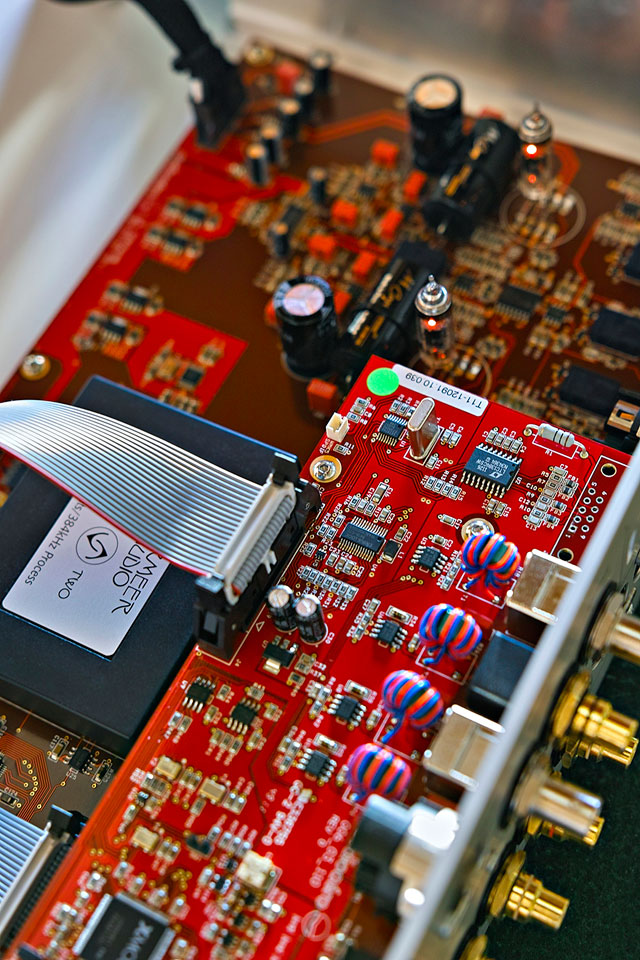

The Model TWO
The Model TWO is essentially a DAC/linestage and is heavily based on the highly praised LaFontaine. Vermeer chose to use the LaFontaine instead of the LaSource to develop the Model TWO because of the large modernity of its platform and therefore its adaptability to new digital sources and new digital decoders. The LaSource was originally developed ten years ago and its configuration would not have allowed any evolution without a complete overhaul of its electronic circuits. Thanks to the development of new DACs, Vermeer’s goal for the Model TWO was simply to get close to the performance of the phenomenal the LaSource.
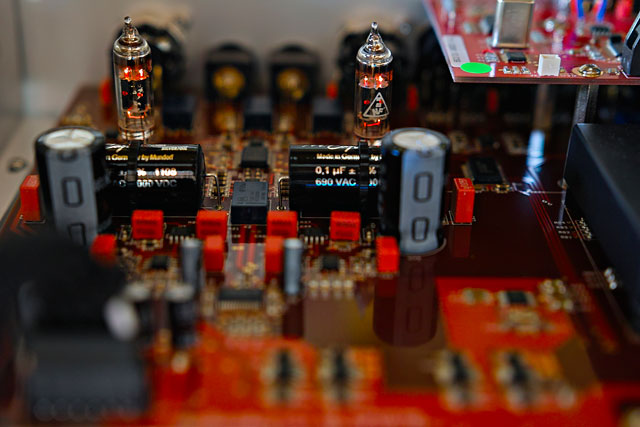
The Model TWO uses 32bit/384kHz conversion circuits and an ultra-low jitter master clock. They allow the reading of most dematerialized files, especially the DSD64 files following the DoP process (DSD over PCM) on the USB inputs but also on the AES/EBU and S/PDIF inputs (except optical input). It comes with both digital and analog inputs and outputs as well as an asynchronous 24/192 USB (PCM and DSD audio data) input for easy connection to computers and music servers.
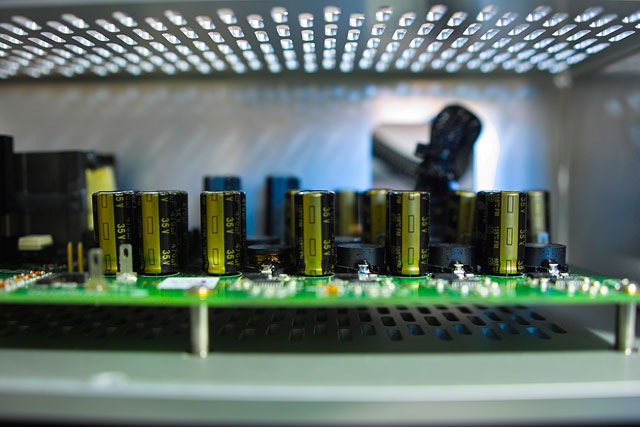
The switching power supplies have been re-engineered for maximum efficiency and reliability with different circuits for the analog and digital circuit boards.Vermeer uses top quality boards with 24K gold plated contacts and 70 ppm copper circuits that allow for perfect data flow. The power supplies are hybrid designs that have been developed to provide extremely stable power with high linearity to each module. Modules also receive their own regulator with specific tension for the application. Both analog and digital stages have their own dedicated power supplies, this eliminates all residual noise and interference between the digital and analog domain. Vermeer also implements the latest generation of Mos-Fet integrated circuitry to lower the noise in the signal path.
The Model TWO is equipped with 3 analog inputs (2 unbalanced RCA and 1 balanced XLR). The output stage and volume control operate in the analog domain. This is achieved by a high quality “ladder” attenuator. Its maximum 7V of output allows the linestage to drive any amplifier. This function can be deactivated from the remote to allow the use an external linestage.
Vermeer’s CEO and Founder, Bruno Ginard says that in the near future, the Model TWO will be available in a network/LAN version. This will allow direct reading on the network of native files up to 32bit/384kHz and DSD up to 11.28 MHz using a LAN input with a Network Attached Storage (NAS). The Network Streaming will be a bit-perfect and jitter-free transmission.
The Model TWO will work with a tablet/smartphone user interface with DLNA compatibility.The analog output section uses a cryogenically treated Thomson 6021 N.O.S. subminiature tube on each channel in cathode-follower mode with a Mundorf Silver & Oil coupling capacitor. There are no sockets for those triodes as they are directly soldered to the board. The model TWO can also be configured for fixed or variable output levels, eliminating the need for a linestage (the volume control and a buffered output stage allow direct connection to a power amp).
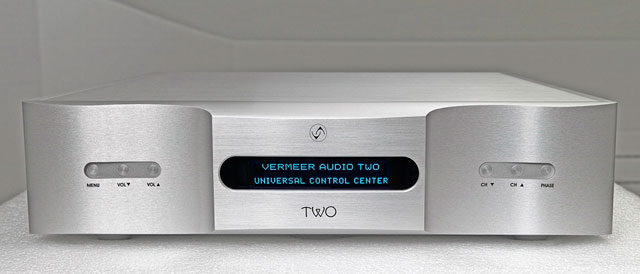
Finally, there’s the chassis. I should point out right here that I was informed that my review unit was technically still a prototype. But the main difference was purely cosmetic. On both sides of the front panel of my unit there are sculpted waves that, on the production models, have been done away with. I’ve seen photos of the new version and it actually does look more elegant without the waves. Now back to the review.
The Model TWO is manufactured of high-grade anodized aluminum. The front panel is manufactured in a 50mm aluminum ingot. On the left side of the panel is a set of recessed soft touch buttons labeled “MENU,” “VOL” (down) and “VOL” (up). On the right are buttons labeled “CH” (down), “CH” (up) and “PHASE.” In the middle is an LED display with very easily readable text (something that means a great deal to an older guy like me). Above the display is the Vermeer logo, and below it is the name of the unit, “TWO.” The top and side panels are made of 10mm aluminum ingot. On the rear panel is where all the action is. On the upper left side of the rear panel are a row of digital inputs (USB, TOSLINK, AES/EBU, S/PDIF, COAX) and one digital output. On the lower left is a “UPGRADE TERMINAL.” Basically, it looks like a USB input for making software upgrades. Next to that are a row of ANALOG inputs and outputs. Finally, on the right side of the rear panel is the MAIN IN and power switch. On the bottom of the unit are three nicely machined aluminum cone feet. This completely inert housing isolates small vibrations and magnetic disturbance that could affect the clock precision.
Overall, a tremendous amount of thought, ingenuity and artistic design went into the building of this unit. Now it’s time to see if it renders music with the same level of passion as it was designed and built.
System and Listening Sessions
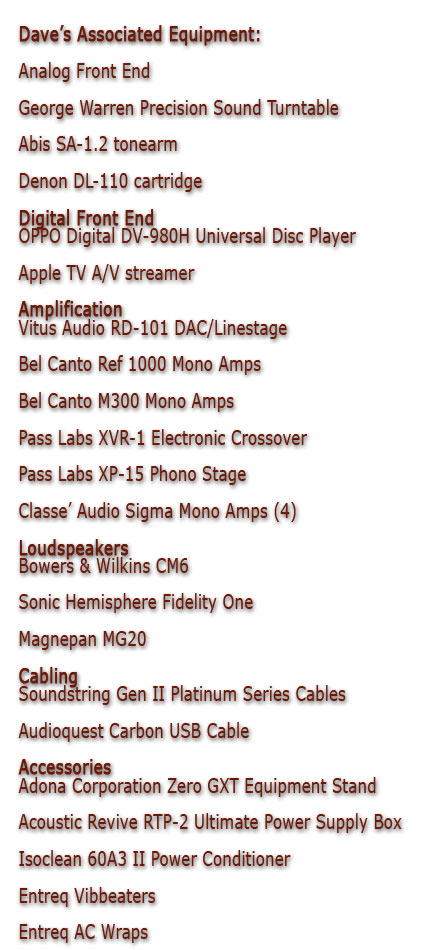 My reference system for this review would consist largely of my usual components. My trusty little OPPO Digital DV-980H disc player (as transport) and my Apple TV streamer feeding digital signals to the Model TWO via its Coaxial and Toslink digital inputs, respectively. The balanced analog outputs from the Model TWO will send the signal to my Pass Labs XVR-1 electronic crossover, which in turn feeds my Bel Canto M300 and REF1000M mono amps. Anchoring the system are my venerable Magnepan MG20 loudspeakers. All of the cabling is the ultra-neutral Soundstring Gen II Platinum cables.
My reference system for this review would consist largely of my usual components. My trusty little OPPO Digital DV-980H disc player (as transport) and my Apple TV streamer feeding digital signals to the Model TWO via its Coaxial and Toslink digital inputs, respectively. The balanced analog outputs from the Model TWO will send the signal to my Pass Labs XVR-1 electronic crossover, which in turn feeds my Bel Canto M300 and REF1000M mono amps. Anchoring the system are my venerable Magnepan MG20 loudspeakers. All of the cabling is the ultra-neutral Soundstring Gen II Platinum cables.
My listening room is approximately 25’ wide by 20’ deep with 8’ ceilings and a carpeted floor. The speakers sit about 4’ from the rear wall and there is approximately 12’ of space between the speakers. The seated listening position is about 12’ from the speakers.
Finally I was ready to start doing some listening. I began listening to CDs feeding the Model TWO’s coaxial digital input. I popped open a couple of discs that I bought during the recent AXPONA show in Chicago. The first disc was the Becca Stevens Band’s Perfect Animal [Universal]. This disc is loaded with wonderful acoustic music and Stevens’ mellifluous voice. Track 7, “You Make Me Wanna” is particularly lovely, and rendered by the Model TWO, is one of those rare tracks that truly immerse you in the performance. Its effect on my system was surprisingly more emotionally involving than even my longtime reference, the Vitus Audio RD-101 (which like the Model TWO is a DAC/linestage) had been. It was a really nice combination of sweetness and authority that I believe most audiophiles look for in a high-fidelity music system.
Next, I wanted to see how live music would be treated by this very neutral sounding DAC. So I put on drummer Lenny White’s, Lenny White Live [BFM Jazz]. This disc really made the most out of the Model TWO’s tube output section. Track 3, “Pic Pocket” features a very pleasing keyboard performance by the great Patrice Rushen. It’s during this performance that you get a wonderful sense of the intimacy of the performance and venue. Her keyboard comes from such a deep and dark backdrop that when the solo ends and the applause come down, it’s nearly jarring because you are so drawn into the music.
 Shifting over to my iTunes library using the Apple TV music streamer into the Model TWO’s optical input, I wanted to experience vocal performances from my new favorite female singer, the dreamy voiced Gretchen Parlato. Live In NYC [Obliq Sound] is her most recent album and I dare say you won’t find a single song on it that you won’t enjoy. There is a fantastic cover of Simply Red’s “Holding Back the Years.” The studio version of this cut is one of my favorite Parlato songs, but live, it’s even more amazing. Her voice is so distinctive and sensual that listening to this disc is an engrossing experience. She often sounds as if she’s in the aftermath of an intense orgasm, and as portrayed by the Model TWO, it’s something that you feel as much as hear.
Shifting over to my iTunes library using the Apple TV music streamer into the Model TWO’s optical input, I wanted to experience vocal performances from my new favorite female singer, the dreamy voiced Gretchen Parlato. Live In NYC [Obliq Sound] is her most recent album and I dare say you won’t find a single song on it that you won’t enjoy. There is a fantastic cover of Simply Red’s “Holding Back the Years.” The studio version of this cut is one of my favorite Parlato songs, but live, it’s even more amazing. Her voice is so distinctive and sensual that listening to this disc is an engrossing experience. She often sounds as if she’s in the aftermath of an intense orgasm, and as portrayed by the Model TWO, it’s something that you feel as much as hear.
While it is important to have a DAC that can push every note of music to your speakers, it is equally important to have a control unit capable of transporting every undistorted particle of sound from your sources to the amplification. The Model TWO performs both of these tasks with a naturalness that keeps the listener focused on the music and not the system. As enchanting as Parlato’s voice is to listen to, the thing that really captivated me was just how ripping her band is. Track 7, “Weak” is a song that does not waste any of its ample rhythm, and the Model TWO does tremendous justice to its many dynamic pace changes and cymbal crashes. Detail, sizzle, slam, and air! This is particularly true of the opening track, “Butterfly.” I upped the volume to nearly live performance levels and the system never lost its composure or musicality. That’s a pretty neat trick for a new company’s first offering. But then again, Vermeer Audio is not exactly a new company.
Conclusion
It has been a rare joy for me to spend time with the Vermeer Audio Model TWO. It’s expensive, yes, but in the world of high end audio, it’s one of the rare components that someone who truly appreciates when art and science form a synergistic bond. It looks high-end, it feels high-end, and most importantly it sounds like what a high-end component should sound like.
I am eagerly looking forward to the other products that are on the horizon for this company. They have already mentioned the coming of a moderately priced DAC called the Model THREE and a cost-no-object unit based on the LaSource called the Model ONE. As for this initial offering, the Model TWO has been more than impressive, it been one of the best musical experiences I’ve had. From the quality of their packaging to the thoughtful design aspects of the Model TWO, Vermeer Audio is a company that demonstrates what high-end audio is all about. I simply cannot recommend this component highly enough.


dave thomas
Specifications:
Vermeer Audio Model TWO
Price: $22,000.00
Contact:
Vermeer Audio
Lyon, France
E-mail: info@vermeeraudio.com
Website: www.vermeeraudio.com
Stereo Times Masthead
Publisher/Founder
Clement Perry
Editor
Dave Thomas
Senior Editors
Frank Alles, Mike Girardi, Russell Lichter, Terry London, Moreno Mitchell, Paul Szabady, Bill Wells, Mike Wright, and Stephen Yan,
Current Contributors
David Abramson, Tim Barrall, Dave Allison, Ron Cook, Lewis Dardick, John Hoffman, Dan Secula, Don Shaulis, Greg Simmons, Eric Teh, Greg Voth, Richard Willie, Ed Van Winkle, Rob Dockery, Richard Doran, and Daveed Turek
Site Management Clement Perry
Ad Designer: Martin Perry





Be the first to comment on: Vermeer Audio Model TWO Universal Control Center